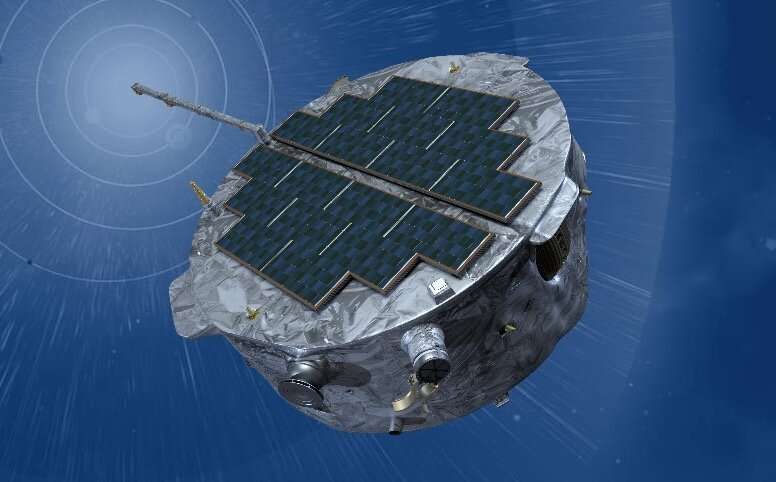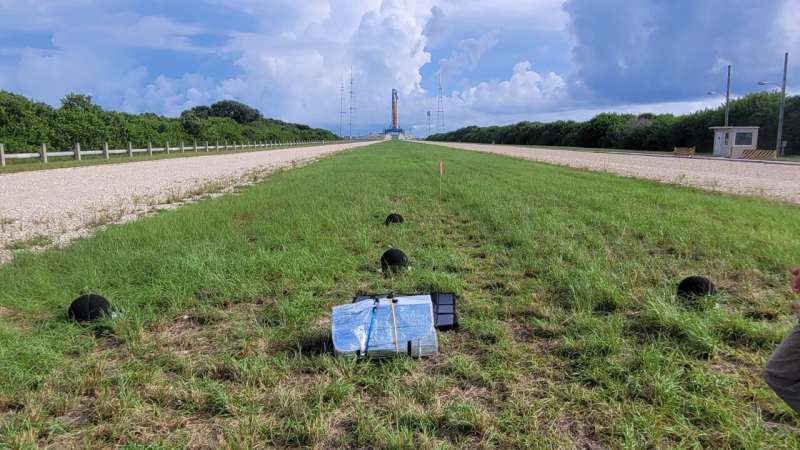
Copernical Team
Phase II of China's deep space observation radar facility kicks off construction
 The second phase of China's deep space observation radar facility, dubbed "China Compound Eye", started construction Tuesday in southwestern Chongqing, according to the Beijing Institute of Technology.
Covering an area of more than 300 mu (20 hectares), the new phase will see the construction of 25 high-resolution radars, each with a diameter of 30 meters, and is expected to be completed i
The second phase of China's deep space observation radar facility, dubbed "China Compound Eye", started construction Tuesday in southwestern Chongqing, according to the Beijing Institute of Technology.
Covering an area of more than 300 mu (20 hectares), the new phase will see the construction of 25 high-resolution radars, each with a diameter of 30 meters, and is expected to be completed i Complex subsurface of Mars imaged by Chinese rover Zhurong
 Ground-penetrating radar from China's Martian rover Zhurong reveals shallow impact craters and other geologic structures in the top five meters of the red planet's surface. The images of the Martian subsurface are presented in a paper published in Geology Thursday.
The Zhurong rover was sent to Mars as part of China's Tianwen-1 mission. Launched in July 2020, the rover landed on the surfac
Ground-penetrating radar from China's Martian rover Zhurong reveals shallow impact craters and other geologic structures in the top five meters of the red planet's surface. The images of the Martian subsurface are presented in a paper published in Geology Thursday.
The Zhurong rover was sent to Mars as part of China's Tianwen-1 mission. Launched in July 2020, the rover landed on the surfac Perseverance shows off collection of Mars samples
 The Red Planet rover snapped a portrait of the sample depot it has assembled with 10 backup sample tubes that could be returned to Earth by a future mission.
Even space robots know what "pics or it didn't happen" means: NASA's Perseverance Mars rover provided a panorama of its recently completed sample depot - a big milestone for the mission and humanity's first collection of samples on an
The Red Planet rover snapped a portrait of the sample depot it has assembled with 10 backup sample tubes that could be returned to Earth by a future mission.
Even space robots know what "pics or it didn't happen" means: NASA's Perseverance Mars rover provided a panorama of its recently completed sample depot - a big milestone for the mission and humanity's first collection of samples on an IMAP completes mission CDR on track for 2025 launch on interstellar mapping mission
 NASA's Interstellar Mapping and Acceleration Probe (IMAP) spacecraft has completed the Mission Critical Design Review and is on track to meet its scheduled 2025 launch. Southwest Research Institute (SwRI) is managing the payload office, providing the scientific instrument Compact Dual Ion Composition Experiment (CoDICE) and is participating on other instrument teams for the mission, which will s
NASA's Interstellar Mapping and Acceleration Probe (IMAP) spacecraft has completed the Mission Critical Design Review and is on track to meet its scheduled 2025 launch. Southwest Research Institute (SwRI) is managing the payload office, providing the scientific instrument Compact Dual Ion Composition Experiment (CoDICE) and is participating on other instrument teams for the mission, which will s Roscosmos is delaying the launch of the replacement Soyuz for crew return
 The launch of the unmanned Soyuz MS-23, a replacement vehicle for the damaged Soyuz MS-22, was postponed until March 2023; it was originally planned to launch on February 19th, 2023, from the Baikonur Cosmodrome in Kazakhstan.
MS-23 will serve as a rescue spacecraft that will bring Cosmonauts Prokopyev, Dmitry Petelin, and NASA astronaut Frank Rubio back to Earth from the International Spa
The launch of the unmanned Soyuz MS-23, a replacement vehicle for the damaged Soyuz MS-22, was postponed until March 2023; it was originally planned to launch on February 19th, 2023, from the Baikonur Cosmodrome in Kazakhstan.
MS-23 will serve as a rescue spacecraft that will bring Cosmonauts Prokopyev, Dmitry Petelin, and NASA astronaut Frank Rubio back to Earth from the International Spa Blue Origin unveils "Blue Alchemist" a technology that turns Moon dust into solar cells
 Jeff Bezos' spaceflight company Blue Origin revealed on February 10, 2023, in their blog that since 2021 they have been developing an in-situ resource utilization (ISRU) technology called "Blue Alchemist" a solar cell and electricity transmission wire prototype by using a material "chemically and mineralogically equivalent" to lunar regolith.
"We can make power systems on the moon directly
Jeff Bezos' spaceflight company Blue Origin revealed on February 10, 2023, in their blog that since 2021 they have been developing an in-situ resource utilization (ISRU) technology called "Blue Alchemist" a solar cell and electricity transmission wire prototype by using a material "chemically and mineralogically equivalent" to lunar regolith.
"We can make power systems on the moon directly Four classes of planetary systems
 Astronomers have long been aware that planetary systems are not necessarily structured like our solar system. Researchers from the Universities of Bern and Geneva, as well as from the National Centre of Competence in Research PlanetS, have now shown for the first time that there are in fact four types of planetary systems.
In our solar system, everything seems to be in order: The smaller r
Astronomers have long been aware that planetary systems are not necessarily structured like our solar system. Researchers from the Universities of Bern and Geneva, as well as from the National Centre of Competence in Research PlanetS, have now shown for the first time that there are in fact four types of planetary systems.
In our solar system, everything seems to be in order: The smaller r Team Aims To Find Earth 2.0
 Are there other Earth-like planets? Is there extraterrestrial life? In the quest to find planets that orbit stars other than the sun, "Earth 2.0" is the Holy Grail. Earth 2.0 is a planet similar enough to Earth to enable the existence of life as we know it. It would be the right temperature for liquid water, and it would orbit a star with a steady supply of light. Ideally, it would be close enou
Are there other Earth-like planets? Is there extraterrestrial life? In the quest to find planets that orbit stars other than the sun, "Earth 2.0" is the Holy Grail. Earth 2.0 is a planet similar enough to Earth to enable the existence of life as we know it. It would be the right temperature for liquid water, and it would orbit a star with a steady supply of light. Ideally, it would be close enou NASA's IMAP spacecraft completes mission critical design review, moves closer to 2025 launch

NASA's Interstellar Mapping and Acceleration Probe (IMAP) spacecraft has completed the Mission Critical Design Review and is on track to meet its scheduled 2025 launch. Southwest Research Institute (SwRI) is managing the payload office, providing the scientific instrument Compact Dual Ion Composition Experiment (CoDICE) and is participating on other instrument teams for the mission, which will study the interaction between the solar wind and the interstellar medium as well as the fundamental processes of particle acceleration in space.
The roar and crackle of Artemis 1

When the Artemis 1 mission was launched by NASA's Space Launch System, SLS, in November, it became the world's most powerful rocket, exceeding the thrust of the previous record holder, Saturn, by 13%. With liftoff came a loud roar heard miles away.
In JASA Express Letters, researchers from Brigham Young University and Rollins College in Florida reported noise measurements during the launch at different locations around Kennedy Space Center.
The data collected can be used to validate existing noise prediction models, which are needed to protect equipment as well as the surrounding environment and community. These data will be useful as more powerful lift vehicles, including the SLS series, are developed.
"We hope these early results will help prevent the spread of possible misinformation, as happened with the Saturn 5," author Kent Gee said. "Numerous websites and discussion forums suggested sound levels that were far too high, with inaccurate reports of the Saturn 5's sound waves melting concrete and causing grass fires.
